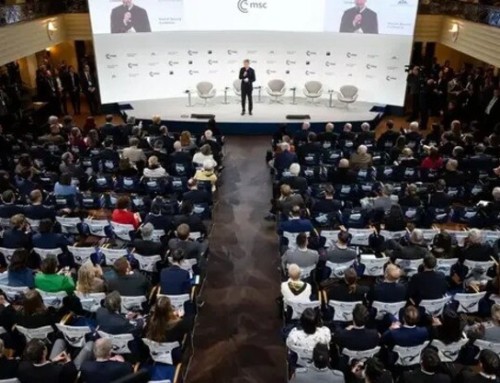 I have always found it strange when others say Europeans are pessimistic about their own fate and that, from outside, Europe is seen in a much better position, especially when discussing the current economic crisis. This is due to my personal experience so far. I have to admit that when I talk about the problems of the European Union, I have often met resistance from Europeans. They assure me that the union will find its way out of the crisis and will emerge even stronger than it is today. I fail to understand how the European approach to problem-solving, which generally involves numerous high-level meetings that fail to achieve the desired consensus and seldom lead to action, will quell Europe’s troubles. I am always somewhat annoyed when Europeans tell me that my views are shaped by the fact that I represent an American company and therefore dismiss them, saying Americans are very skeptical toward the European Union and its future.
I have always found it strange when others say Europeans are pessimistic about their own fate and that, from outside, Europe is seen in a much better position, especially when discussing the current economic crisis. This is due to my personal experience so far. I have to admit that when I talk about the problems of the European Union, I have often met resistance from Europeans. They assure me that the union will find its way out of the crisis and will emerge even stronger than it is today. I fail to understand how the European approach to problem-solving, which generally involves numerous high-level meetings that fail to achieve the desired consensus and seldom lead to action, will quell Europe’s troubles. I am always somewhat annoyed when Europeans tell me that my views are shaped by the fact that I represent an American company and therefore dismiss them, saying Americans are very skeptical toward the European Union and its future.
This is why I was a bit shocked when I heard a representative of the World Bank say that Europeans should stop being so pessimistic, and that from the United States, Europe is seen in a much better light. The World Bank’s Chief Economist for Europe and Central Asia, Intermitt Gill, visited Bucharest on Feb. 18 to present a report that was released a year ago in Brussels and whose findings, in his opinion, still stand. The presentation was meant to assure the public that the European model is still key to solving the Continent’s problems and should not be abandoned. Therefore, I felt cautiously happy that I have to concede that a European model does indeed exist and is in fact quite successful, despite the problems of which I am all too well aware. Happy because, after all, I live in Europe, and I share the dream European Union represents. I soon learned from his speech that the European model is defined by the convergence machine designed in the 1970s and meant to bring all the EU member countries to similar levels of socio-economic development. This is in fact the process that all the Central and Eastern Europeans were hoping to take advantage of in the early 1990s when they started dreaming about integration into the European Union. There are good reasons to keep the machine working in the World Bank’s view — the benefits of capital flows, trade, and labor markets — and all of them are of particular benefit to the countries of Central and Southeastern Europe.
The data Gill shared on a series of power-point slides reminded me of research conducted in 2008 and early 2009, when we at Stratfor were investigating how the economic crisis would affect Central Europe. Back then, there were very few voices talking about the crisis spreading in Europe, and even fewer were thinking about the implications for Central and Southeast Europe. But we noted capital flows that to us seemed to entail a high risk for the region — specifically, we were looking at the risks incurred by Austrian banks. At the time, we wrote:
“The practice of lending in foreign currency — mainly in euros and Swiss francs — was a popular strategy for retail banking in the region. However, it is becoming increasingly problematic in countries like Hungary, Romania and Croatia, which are facing weakening currencies and have underlying weak economic fundamentals (such as high government budget deficit, high trade deficit and high inflation) that cause wild swings in the value of the currency. Foreign currency lending was a lucrative way for particularly Austrian banks to expand into Central Europe and the Balkans and quickly gain a market share that dwarfs their domestic market.”
After deeper investigation, we put together a larger report in Aug. 2009 saying that:
“STRATFOR considers Central Europe “ground zero” of the global recession. Before the crisis, the region was flying high on foreign direct investment, overtaking East Asia as the main destination for international capital in 2002. However, the massive influx of foreign capital that made the boom years possible is now the source of a very large problem for the region.”
Continuing, we explained why Central Europe’s problems were not limited to economics:
“To understand how Central Europe became the emerging market and main destination for international capital, one has to understand the scope of geopolitical changes worldwide. First, the 1990s saw the decline of Russian power in what has traditionally been its sphere of influence, allowing most Central European countries to consolidate politically under the twin EU and NATO umbrellas between 2004 and 2007. The scope of Russian withdrawal from the region was massive and unprecedented, and seemed permanent at the time. The Baltic states in particular, under tight and direct control by Moscow for more than 80 years, were suddenly open for business from the West, with Scandinavian banks first to cash in, reestablishing what had been Stockholm’s sphere of influence in the 17th century. Global credit expansion post-2001 also happened to roughly coincide with the fall of Serbian strongman Slobodan Milosevic in October 2000, which greatly relaxed political instability in Southeast Europe. Suddenly, even the Balkans were open for business.”
Considering that Central Europe was seen after 2001 as holding the last unexploited lending markets in the world, it is at the very least awkward to listen to a report released in 2012 explain that the benefits of capital flows are clearly seen when “capital flows from richer to poorer” countries. It is precisely those capital flows, and the fact that they were not accompanied by structural changes to national economies, that caused the current problems of Greece and other South European countries. This is why, in 2010, we took seriously the possibility of a serious, existential crisis of the Eurozone. We were shrugged off as euroskeptics until 2011, when Greece’s case grew too severe to be ignored — though even at that time, few conceded that it is the cycle of debts precipitating the collapse that was yet to come.
The other factor presented in the World Bank report was related to trade – indeed, the report presents the growing sophistication over time of countries from Central and Southeastern Europe, but it does not focus on specifics showing the balances and net gains for those countries. One cannot fault the authors for ignoring the structural aspects of Central European countries, and failing to analyze the national economic impact of their status as net importers, without crediting the report for mentioning that Western countries like Germany are dependent on the income coming from the exports to these regions. That is true, of course, but, as George Friedman says:
“The free-trade zone that was the foundation of the European Union was also one of the foundations of the German economy. The pricing of the euro aided German exports, and regulations in Brussels gave Germany other advantages. The European Union, as it existed between 1991 and 2008, was critical to Germany. However, the European Union no longer functions as it once did. The economic dynamics of Europe have placed many countries at a substantial disadvantage, and the economic crisis of 2008 triggered a sovereign debt crisis and banking crisis in Europe.”
The tensions between France and Germany, which were on full display this past week, are particularly influenced by trade evolutions within the European Union and their impact on the euro’s market value. While France supports weakening the euro, arguing this will make the eurozone more competitive, Germany, even as it acknowledges that the euro’s value harms the ability of peripheral countries to increase their exports, is not willing to accept a weaker euro.
The third pillar of the European economic model as shown in the World Bank report is the creation of the free labor market, leading to the free mobility of workers. Statistics from the 1980s through 2008 can indeed foster optimism — you can see the increase in labor force movement. However, we are currently seeing a growing criticism of this foundational pillar of the European Union, in large part because of problematic demographics and rising nationalism in the European Union.
The report also outlined the major sources of inefficiency in Europe: the social security systems and low innovation compared to the United States. Europe’s social security systems need to be analyzed in close connection with the labor market and the Continent’s demographics when looking at the social problems that European Union has today. Most importantly, I believe, we should look at youth unemployment and its complexities.
The guidelines and recommendations of the World Bank report, while useful for a functioning European Union, are not suitable for the shaken and somewhat tired European Union we see right now. The report met resistance in the audience from prominent Romanian economist Daniel Daianu, who outlined some of the problems that the researchers writing up the report had left out, and that is when the World Bank optimists underlined European pessimism.
More interestingly, the author of the report revealed that the Polish National Bank, the client for this report, had in fact requested an overview of the risks that the social security system could meet when entering the eurozone – a question that was “not really answered”. Poland is constantly struggling to ensure that non-eurozone members aren’t sidelined while other members focus on deepening integration of the eurozone. Legally, Poland is obliged to join the eurozone at some point. However, Warsaw first wants to see the currency union stabilize and is still assessing the effects on the national economy that releasing its monetary policy would have. This suspicion toward deeper integration is rooted in every European state and is one of the existential problems the European model






Leave A Comment